CHIPSat (Cosmic Hot Interstellar Plasma Spectrometer Satellite)
Non-EO
Quick facts
Overview
| Mission type | Non-EO |
| Launch date | 13 Jan 2003 |
| End of life date | 11 Apr 2008 |
CHIPSat (Cosmic Hot Interstellar Plasma Spectrometer Satellite)
CHIPSat (Cosmic Hot Interstellar Plasma Spectrometer Satellite) is a technology demonstration mission of UCB (University of California at Berkeley, PI: M. Hurwitz), supported by NASA's UNEX (University-class Explorer) program, with the objective to obtain spectral sky maps of the scientifically critical EUV (Extreme Ultraviolet) band between 90-260 Å. CHIPSat is in fact NASA's first UNEX mission. The CHIPS full-sky survey helps to determine the electron temperature, ionization conditions, and cooling mechanisms of the so-called “local interstellar bubble,” a cloud of hot gas surrounding our solar system that extends about 300 light-years from the sun. 1) 2) 3) 4) 5)
Background
The CHIPS (Cosmic Hot Interstellar Plasma Spectrometer) project was selected by UNEX in 1998. The CHIPS mission (i.e. the instrument) was initially proposed as a secondary payload aboard a FAISat communications S/C. This approach was dropped in favor of a small spacecraft with a single instrument payload. Thus the CHIPS project mutated to CHIPSat.
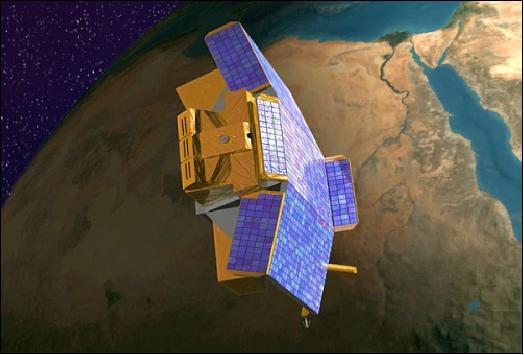
Spacecraft
CHIPSat is a dedicated microsatellite built by SpaceDev, Inc. of Poway, CA for UCB/SSL (Space Sciences Laboratory). CHIPSat is a three-axis stabilized S/C using 4 momentum wheels (Dynacon MicroWheel 200), three torque coils, two sun sensors, magnetometer, a moon sensor, and rate sensors to provide an attitude pointing accuracy within ±2º. The magnetorquers are being used to balance residual spacecraft dipole and dump built-up momentum from the wheels. The S/C is nominally sun-pointing with complete freedom to yaw about the solar array normal vector allowing the CHIPS instrument to obtain a full-sky survey within six months, while avoiding pointing the instrument FOV at the sun, Earth, moon and in the orbital RAM direction. The design permits access to all points on the celestial sphere within the one year mission lifetime. 6) 7) 8)
The S/C structure employs the BD-II spacecraft bus of SpaceDev, using a milled aluminum transition adapter and aluminum honeycomb panels with facesheets for structural integrity. Power (106 W EOL) is provided by body-mounted solar arrays using dual-junction GaAs/InP/Ge solar cells; NiCd batteries are used during solar eclipses. In addition, small keep-alive arrays are positioned on the other five sides of the S/C providing enough power to run critical subsystems regardless of the S/C attitude. A passive thermal subsystem is used for CHIPSat. The C&DH (Communications and Data Handling) subsystem employs a single-board computer (Motorola Power PC 750 CPU, memory, and I/O for distributed processors). The S/C mass is 64 kg, power = 42 W, its size is about 1 m x 1 m x 0.5 m, the design life is 18 months (one year mission).
The CHIPSat system provides a design that utilizes COTS (Commercial-off-the-Shelf) philosophy. The avionics electronic components are primarily commercial grade with industrial temperature range. For internal communications within the bus, standard COTS interface protocols are used, most notably RS-422 and RS-485. Because TCP/IP is used for end-to-end communications, almost all hardware in the ground segment is COTS; in addition, almost all communications-related software is built into the COTS operating systems used for both the ground and space segments. The interface between the spacecraft and the ground segment consists of an HDLC point-to-point link layer. Layered within the HDLC frames is a standard TCP/UDP/IP protocol stack that, when combined with VPN (Virtual Private Network) and firewall-protected use of the commercial Internet, allows end-to-end data flow between mission control centers, science operations centers, and the spacecraft. The use of COTS Internet tools opened up a wide range of easily implemented operational capability including distributed and easily portable integration and test and mission operations.
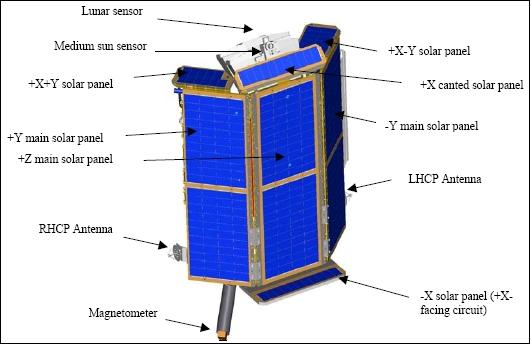
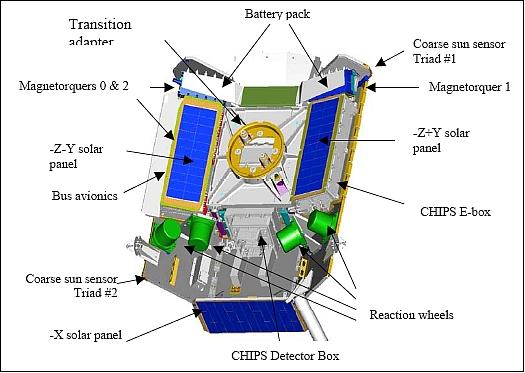
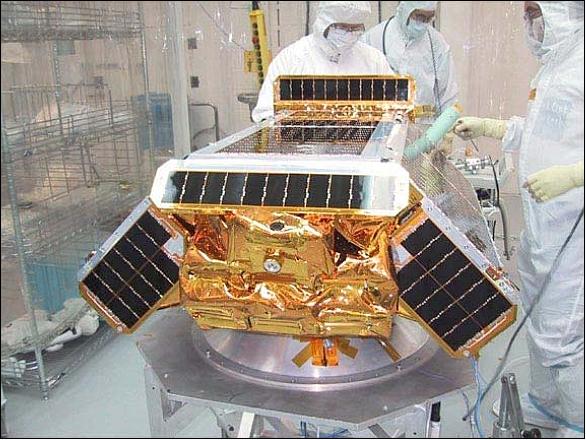
Launch
CHIPSat was launched as a secondary payload, along with ICESat as primary payload, on January 13, 2003 (UTC) on a Delta-2 7320-10 rocket from VAFB, CA. 9)
Orbit: circular orbit, altitude of 190 km x 1200 km (initial) and 590 km (final), inclination = 94º, orbital period of 96.23 minutes. - Note: The 190 km x 1200 km orbit was the initial orbit in which the Delta-2 2nd stage, with CHIPSat still attached, was left when the 3rd stage separated. Then, the 2nd stage was fired twice again, first to lower the apogee, then after 45 minutes, to raise the perigee. Only then did CHIPSat separate from the 2nd stage. The CHIPSat spacecraft doesn't provide any onboard propulsion.
CHIPSat Communications
CHIPSat is the first NASA mission to use end-to-end satellite operations with TCP/IP and FTP (File Transfer Protocol). This concept has been analyzed and demonstrated by the NASA OMNI team via UoSAT-12. However, CHIPSat is the first spacecraft to implement the TCP/IP concept as the only means of satellite communications.
The RF communications are in S-band. The transceiver is composed of a transmitter and separate receiver which are combined via a highly selective diplexer and split into two (RHCP & LHCP) antennas to provide near 4π coverage. The system utilizes FSK modulation for both uplink and downlink, and utilizes rates of 4-9.6 kbit/s and 38.4 - 115.2 kbit/s respectively.
The TCP/IP and UDP/IP (User Datagram Protocol/Internet Protocol) protocol suite is used to communicate all data between the S/C and the ground user directly. Data is received, archived, and monitored at MCC (Mission Control Center) at SpaceDev, and then sent to SOC (Science Operation Center) at UCB/SSL via Internet.
The UDP/IP (User Datagram Protocol) protocol is selected for real-time monitoring and real-time commanding (it de-couples both directions) and presents much less overhead. The setup permits the reception of engineering and status packets (telemetry) in case the uplink isn't working. Conversely, the setup permits also to command “into the blind” by uplinking UDP packets in case the telemetry isn't working.
Note: The UDP service of the TCP/IP protocol permits to send discrete packets of information called “datagrams” that aren't guaranteed to get there and may arrive out of order depending upon their routing through the IP system. A two-way communication isn't needed in this setup because the data are broadcast. So, if a guarantee is needed that at least some packets get through, even if one direction of the communication link fails, then UDP may be used. - TCP deals with making sure that all the packets arrive and are in the correct order. TCP implies a two-way connection and a higher level of communications overhead to assure that all the packets arrive and are in the correct order.
The spacecraft takes advantage of the innate capabilities and common tools of the Internet to manage time synchronization between the ground and the spacecraft. These include NTP (Network Time Protocol) on the SpaceDev TCP/IP data routers located at the ground stations and SNTP (Simple Network Time Protocol) running on the spacecraft operating system. The software running on the spacecraft periodically requests a time update from the ground station, and after a successful SNTP echo, the spacecraft clock is aligned to UTC (estimated at better than 100 milliseconds).
Mission Status
• The CHIPSat mission was retired on April 11, 2008 — after 5 years of successful operations. The reason for its retirement was simply that NASA didn't provide a budget to continue the low-cost operations of the mission. 10) 11) 12)
• In mid-January 2005, CHIPSat was operating for two years in orbit. 13)
• During the first six months of the mission, the CHIPSat spacecraft has been able to perform per its design requirements. However, several anomalies (both expected and unexpected) have occurred. Since the start of science data collection, the net duty cycle for the acquisition of science data is ~ 95%. - Due to the use of non-radiation-hardened commercial electronics, a number of SEE (Single-Event Effect) events were expected.
• Throughout the early period, mission operations were conducted from the mission operations center at SpaceDev Inc., with only instrument commands originated at Berkeley. Operation of the satellite from the SpaceDev facility was crucial, as it enabled the most experienced and knowledgeable spacecraft engineers to participate in the day-today (sometimes moment-to-moment) decision making. As operations as a whole became routine, however, it became advantageous to rely on the mission operations personnel and infrastructure developed primarily for the HESSI and FAST missions already in place at Berkeley. Operations were transitioned to Berkeley in late May 2003, with SpaceDev continuing to participate in periodic meetings and as required to resolve anomalies (Ref. 14).
• Three anomalies have occurred to date relating to the onboard reaction wheels. CHIPSat is the second mission with four microwheels (the first mission is FedSat); like the flight computer, the wheel design primarily employs commercial parts. One wheel incurred a communication failure; as a result, the spare wheel is being used for active ACS control.
• The spacecraft was detumbled on January 20, 2003. Checkout and commissioning of the attitude control system and spectrograph occurred over the following weeks. The detector door was opened on January 26. By February 2, all six of the entrance slit covers had been opened to their 1mm or "wide" positions (the first detente following the closed positions employed during launch). Astrophysical observations ramped up in early February as commissioning activities wound down. 14)
Sensor Complement (CHIPS)
CHIPS (Cosmic Hot Interstellar Plasma Spectrometer):
CHIPS is a low-cost instrument with high sensitivity and spectral resolution in the spectral band near 170 Å, designed and built at UCB/SSL. The science objectives are to carry out EUV spectroscopy to determine how the million degree gas-cloud surrounding our solar system, cools. - The CHIPS instrument uses an array of grazing-incidence optics to achieve a peak resolving power of f/150 for diffuse emission in a field of view (FOV) of 5º × 26.7º (the gratings are aligned in one dimension on the sky).
Light enters the spectrograph through the array of six entrance slits (channels). The entrance apertures are narrow slits, each covered by a rotating mechanism with closed, narrow, and wide settings to protect the interior from contamination during launch. The gratings disperse and focus the diffuse extreme ultraviolet radiation onto a single detector through a filter assembly. The detector is a planar, photon-counting MCP (Micro Channel Plate) with a crossed delay line anode. In-band photon locations are determined from the anode, which converts the light into analog electronic pulses. 15) 16) 17)

Note: The use of variable line-spaced gratings in instruments is of EUVE and ORFEUS (Orbiting Retrievable Far and Extreme Ultraviolet Spectrograph) instrument heritage. The ORFEUS payload flew twice with the ASTRO-SPAS missions on STS-51 (Sept. 12-22, 1993)) and on STS-80 (Nov. 19 - Dec. 7, 1996). The NASA satellite EUVE (Extreme Ultraviolet Explorer) was launched June 7, 1992.
Parameter | Value | Parameter | Value |
Entrance slits | 0.027 cm x 6 cm | Nr. of spectral channels | 6 |
Grating graze angle | 14º | FOV (Field of View) | 5º x 26.7º |
Groove density | 1625-1900 mm-1 | Bandpass | 90 - 260 Å |
Grating curvature | 148 cm | Spectral resolution | 45-155 (lambda/delta lambda) |
Grating dimensions | 8 cm x 6 cm x 1.2 cm | Aeff x Omega | (1.3-8.8) x 10-4 sr |
Optical coatings | Rhodium | Payload mass | <25 kg (spectrograph) 10 kg (electronics box) |
Detector area | 5.0 cm x 6.0 cm | Payload power | 21.2 W (average) 30 W (peak) |
Photocathode | NaBr | Attitude control | ±2º |
EUV filters | 720 Å Polyimide; 500 Å Boron, 1000 Å Al; 300 Å C | Data rate | >16 MByte/24 hours |

Figure 7 provides a block diagram of the CHIPS electrical system and principal interfaces. The photon-counting system converts light focused on the spectrometer's photosensitive front surface into a stream of digitized photon coordinates. In-band photon locations are determined using a XDL anode, converting the light into analog electrical pulses. RF amps amplify the anode signal and the pulses are converted into digitized coordinates by a TDC (Time Digital Converter) in the instrument EBOX (Electronics Box). The digitized events are transmitted to a DPU/HK (Data Processing and Housekeeping Unit) for processing. The DPU/HK board packages and formats all instrument data for transmission to the CHIPSat SBC (Single Board Computer) via redundant asynchronous RS-422 links. Science and instrument HK data is then stored within the spacecraft memory and combined with orientation data prior to downlink.
Low-current power to the instrument LVPS (Low Voltage Power Supply) and high-current power to the instrument door and cover actuators is supplied directly from the spacecraft 14 V batteries. The LVPS incorporates its own power converters to generate the required secondary voltages. The spacecraft provides switched heaters to keep the instrument within its survival temperature range.
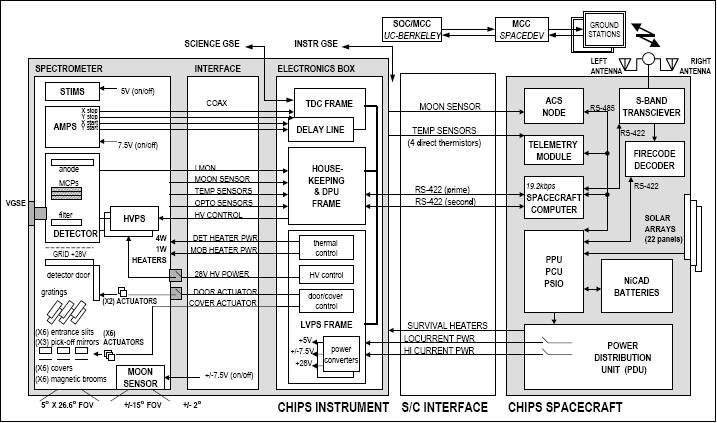
The TDC (Time to Digital Converter) is responsible for processing valid photon events [converting analog pulses from the RF amps to digital detector (x, y) coordinates and charge amplitudes] and rejecting subthreshold or incomplete events.
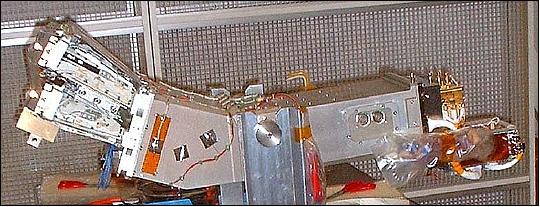

Among the challenges on CHIPS were initial coalignment of the spectrometer channels, and maintenance of coalignment in the presence of thermal gradients and launch dynamics. Each spectrometer channel is a relatively slow (f/14) optical system, and therefore optical misalignments on the order of the slit width are tolerable with small degradation in spectral resolution. Because the spectrograph combines slit images from six separate channels, slit images must be coaligned, and coalignment maintained, within a small fraction of their size on the focal plane (~250 µm).
Initial alignment was achieved using 5mm visible ruling patches on the ends of the gratings. A HeNe laser was split into four beamlets by 25%, 33% and 50% reflection beamsplitters. Beamwalk mirrors were used to direct pairs of beamlets through the entrance slit, off the visible patches, to the focal plane at the cross-dispersion extremes of the detector. During visible light alignment, the detector was replaced with a ground glass surrogate detector, and a pair of CMOS cameras used to image the ground glass screen near the extremes of the spectral feature. A wire fiducial mounted on the ground glass served as a coalignment target. The alignment technique is beyond the scope of this paper, but based on recognizing optical distortion and misalignment by the differences in the “speed” of motion of the near and far visible patch spots, on the focal plane, for a given grating angular motion. Initial alignment was achieved when all four spots were positioned on the wire. Fine alignment was performed with removable 80 thread per inch micrometers, based on measurements made at EUV wavelengths in the vacuum calibration facility.
References
1) E. Taylor, M. Hurwitz, W. Marchant, M. Sholl, S. Dawson, J. Janicik, J. Wolff, “CHIPS: A NASA University Explorer Astronomy Mission,” Proceedings of AIAA/USU Conference on Small Satellites, Logan, UT, USA, Aug. 11-14, 2003, SSC03-V-3
2) W. Marchant, E. Riddle Taylor, “Status of CHIPS: A NASA University Explorer Astronomy Mission,” Proceedings of the 14th AIAA/USU Conference on Small Satellites, Logan, UT, Aug. 21-24, 2000, SSC00-V-6
3) M. Hurwitz, W. Marchant, M. Sholl, E. Riddle Taylor, “Status of CHIPS: A NASA University Explorer Astronomy Mission,” AIAA/USU Conference on Small Satellites, Aug. 13-16, 2001, Logan, UT, SSC-091-V-7
4) Courtesy of Will Marchant of UCB/SSL
5) Jeffrey Janicik, Jonathan Wolff, “The CHIPSat Spacecraft Design - Significant Science on a Low Budget,” Proceedings of SPIE,'UV/EUV and Visible Space Instrumentation for Astronomy II,' Vol. 5164, Aug. 2003, San Diego, CA, USA, URL: http://chips.ssl.berkeley.edu/JanicikSPIE.pdf
6) http://chips.ssl.berkeley.edu/chips.html
7) “Cosmic Hot Interstellar Plasma Spectrometer (CHIPS): Studying the Interstellar Medium,” NASA/GSFC, FS-2002-11-048-GSFC, URL: http://www.nasa.gov/centers/goddard/pdf/110914main_FS-2002-11-048-GSFC-CHIPS.pdf
8) http://science.nasa.gov/missions/chips/
9) “Delta / ICESat/CHIPSat Mission from VAFB Pad SLC-2,” URL: http://science.ksc.nasa.gov/payload/missions/icesat/
10) “CHIPSat Quietly Shut Down,” June 4, 2008, URL: http://www.redorbit.com/news/space/1417075/chipsat_quietly_shut_down/
11) Information provided by Mark Hurwitz of SSL at UCB (University of California, Berkeley)
12) M. J. Sholl, Geoff Gaines, Martin Sirk, Ellen Taylor, Mark Hurwitz, “CHIPS Microsatellite Optical System: Lessons Learned,” Proceedings of SPIE, Vol. 7071, 707104-1, 2008, doi: 10.1117/12.799573, URL: http://144.206.159.178/ft/CONF/16419962/16419964.pdf
13) “SpaceDev's CHIPSat Celebrates Second Anniversary in Space,” SpaceRef, Jan. 20, 2005, URL: http://www.spaceref.com/news/viewpr.html?pid=15956
14) Mark Hurwitz, the CHIPS Instrument Team, and CHIPSat Spacecraft Team, “Current status of the Cosmic Hot Interstellar Plasma Spectrometer (CHIPS) University-class Explorer Mission ,” Proceedings of SPIE, 'UV/EUV and Visible Space Instrumentation for Astronomy II,' Ed. Oswald H. W. Siegmund, Vol. 5164, 24, San Diego, CA, August 2003, URL: http://chips.ssl.berkeley.edu/Hurwitz_CHIPS_SPIE_San_Diego_II.pdf
15) “The CHIPS Instrument,” URL: http://chips.ssl.berkeley.edu/instrument.html
16) M. Sholl, B. Donakowski, G. Gaines, M. Lampton, M. Hurwitz, M. M. Sirk, E. Taylor, “Optics design and performance for the Cosmic Hot Interstellar Plasma Spectrometer (CHIPS),” URL: http://chips.ssl.berkeley.edu/SPIE-5164-09_V0.pdf
17) M. Sholl, W. Donakowski, M. M. Sirk, T. Clauss, M. Lampton, J. Edelstein, M. Hurwitz, “Opto-mechanical Design of the Cosmic Hot Interstellar Plasma Spectrometer (CHIPS),” URL: http://www.astro.caltech.edu/~srk/MiniSat/InterestingProjects/OptMechDesign.pdf
The information compiled and edited in this article was provided by Herbert J. Kramer from his documentation of: ”Observation of the Earth and Its Environment: Survey of Missions and Sensors” (Springer Verlag) as well as many other sources after the publication of the 4th edition in 2002. - Comments and corrections to this article are always welcome for further updates (eoportal@symbios.space)